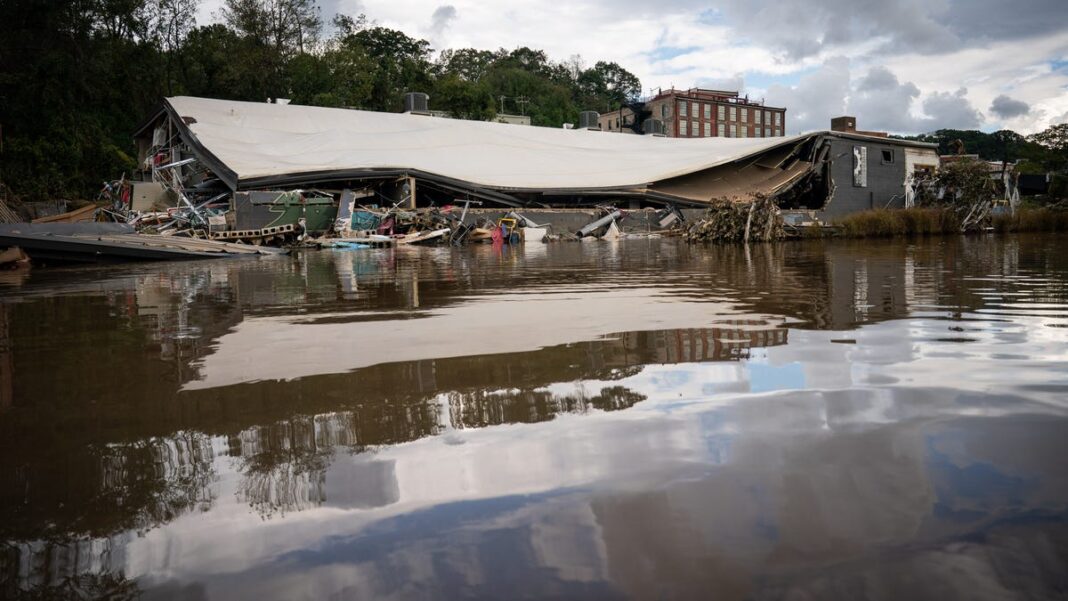Hurricane Helene Causes Significant Damage, Highlighting Flood Insurance Shortcomings
On Friday afternoon, while enjoying a cup of coffee on her porch, Kayla Ward observed the Nolichucky River rising rapidly.
Having lived in her house in the Appalachian Mountains for almost a year, Ward never considered the possibility of flooding. However, when Hurricane Helene struck Jonesborough, Tennessee, she and her husband had to hurriedly flee, taking only their pets and the clothes they were wearing. Unfortunately, their home suffered extensive damage.
Like many others affected by the storm, Ward did not possess flood insurance, and her husband’s claim was denied by their insurance provider. This was unexpected for Ward, 61, who previously worked as an insurance claims specialist at a full-service agency in nearby Johnson City.
“We’ve discovered that everyone in our area is in the same situation. No one is receiving coverage,” she stated to YSL News. “We lost everything. Utterly everything.”
The devastation caused by Hurricane Helene across the Southeastern United States has drawn attention to the lack of flood insurance coverage. A FEMA report indicates that only about 4% of homeowners in the U.S. have this type of insurance.
“The situation is grim regarding the availability of insurance funds for households needing repairs,” remarked Amy Bach, executive director of the consumer advocacy organization United Policyholders. “The number of affected homes with flood insurance is far too low.”
A Major Insurance Gap
Damage estimates have yet to be released, but earlier reports from YSL News indicated that insured property damage in Florida and Georgia alone could exceed $3 billion, according to CoreLogic, a financial services firm. This hurricane stands out as one of the deadliest to hit the U.S. mainland, resulting in over 100 fatalities, and has been called North Carolina’s “Hurricane Katrina,” which once caused an estimated $125 billion in damage (not adjusted for inflation).
However, the destruction from Katrina had notable differences. Many individuals affected by the 2005 hurricane received insurance claim approvals because the damage was attributed to wind, according to Bach. In contrast, much of the damage from Helene resulted from flooding and storm surges.
“We can’t use wind damage as an argument for home insurers this time,” she added.
Many homes lack flood insurance for two main reasons: cost and lack of awareness.
According to Bach, some homeowners don’t realize that flood insurance must be purchased separately from standard homeowners insurance.
“There is certainly an information gap,” she stated. “Insurance regulators and public officials continuously seek ways to educate people that flood damage is usually excluded from their regular insurance policies, but many homeowners avoid thinking about insurance altogether.”
Others find it difficult to afford additional flood insurance or believe that the investment isn’t justified. Typically, flood insurance through the National Flood Insurance Program averages around $1,000 annually, as previously reported by YSL News’s Blueprint. This cost comes on top of rising homeowners insurance rates, which increased significantly in 2023 as noted by S&P Global Market Intelligence.
According to Tim Zawacki, an insurance strategist at S&P Global, insurance rates are predicted to keep climbing. He anticipates that homeowners insurers will reassess their risks “in various locations” following Helene’s impact on areas far from the coast.
“As insurance companies reduce their risk exposure to stabilize earnings, we will inevitably see an increase in homeowners insurance premiums,” Zawacki mentioned in an email to YSL News.
‘A False Sense of Security’
However, FEMA’s flood maps are frequently outdated or incomplete. According to a 2020 report from the Association of State Floodplain Managers, only a third of the nation’s floodplains have been mapped by FEMA.
“Often, these maps can lead to a false sense of security,” said Sharon Cornelissen, director of housing at the Consumer Federation of America. “As climate-related disasters increase and storms become more intense and frequent, it’s clear that the actual risk of flooding is much broader.”
With 99% of counties across the nation experiencing flooding since 1996, FEMA identifies floods as the most common and costly natural disasters in the United States.
“The lack of flood insurance represents the most significant insurance gap,” noted Mark Friedlander, director of corporate communications at the Insurance Information Institute. “Although some homeowners might face a greater risk than others, it’s important to recognize that no one is completely safe from risk, regardless of their location.”
What homeowners should do next
For those affected by Helene who do not have flood insurance, experts consulted by YSL News provided guidance on the best steps to take.
- Prioritize drying out your home promptly, while being vigilant for potential scams. There will be a limited number of contractors available to assist with drying, so it’s essential to thoroughly check the credentials of any business offering help.
- Document the damage with clear photos and videos.
- Review your homeowners insurance policy. According to Bach, there may be some coverage available for specific costs under your home policy, particularly if you can attribute the damage to wind-driven rain. It’s advisable to seek a second opinion before concluding that the damage won’t be covered.
- Apply for FEMA assistance and look into any emergency funding available through state or local agencies. Though FEMA can provide some help, Friedlander cautioned that it’s not a substitute for insurance; between 2016 and 2022, the average FEMA disaster assistance grant was only $3,000, while just one inch of water can inflict approximately $25,000 in property damage.

